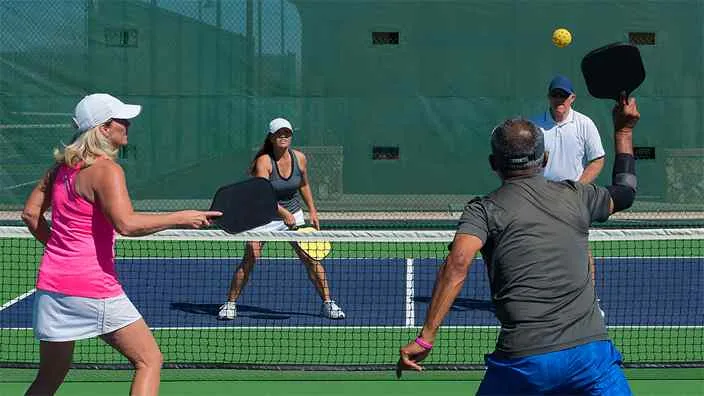As pickleball's popularity has skyrocketed - rating systems help match players of similar abilities for competitive, engaging games. In this article, we’ll help you understand pickleball ratings and the concept of self-rating so that you can find ideal opponents and teammates yourself.
Quick Answer: Rate yourself by honestly assessing your skills, and validate by playing matches against higher-rated opponents. Using rating calculators as a baseline along with feedback from coaches and experienced players helps dial in your accurate rating.
Table of Contents
- Pickleball Rating System
- What Is The Purpose Of Pickleball Ratings?
- Where Do You Find Your Pickleball Rating?
- What Are The Pickleball Ratings?
- USA Pickleball Tournament Player Rating Calculation
- Way Of Rating Yourself In Pickleball
- How To Rate Yourself In Pickleball Calculator?
- Frequently Asked Questions
- Conclusion
First things first, the rating system is based on USA Pickleball Association guidelines. With ranges/skill levels such as:
- 1.0-2.0 Beginners Learning Basics
- 2.5-3.5 Intermediate Developing Techniques
- 4.0-5.0 Advanced Competitive Players
Players in the 1.0 to 2.0 range are still learning basic skills like serving, returning serves, and sustaining rallies. Beginners are focused on generating consistent shots over the net from the baseline and developing control. They are still learning court positioning, strategy, and rules. Safe to say, beginners are working on just keeping the ball in play.
Intermediate pickleball players in the 2.5 to 3.5 range have mastered fundamentals and are developing more advanced techniques. They can serve and return effectively, sustain longer rallies using forehand and backhand shots, and move around the court with better footwork. Dinking, volleying, and placement start improving. Players become more reliable during games.
Players rated 4.0 to 5.0 exhibit skills mastered from tournament play and intense training. They employ advanced shots like overheads, half volleys, and drop shots. Serves, returns, and third shots are well-controlled. The 5.0 skill ceiling represents elite players competing at the highest pickleball championship level.
If you are questioning the purpose of the ratings then you should give this a read:
- Groups Players By Skill Level - Ratings allow players of similar abilities to be grouped together for matches that are challenging yet competitive.
- Facilitates Organized Play - Ratings are essential for creating fair tournament brackets, intramural leagues, round robins, and ladder play based on skill.
- Tracks Player Progression - Ratings provide milestones for players to work towards as they improve.
- Promotes Skill Development - Having defined ratings motivates players to hone techniques and strategies to reach the next level.
- Allows Self-Evaluation - Being rated also provides feedback from others.
- Equalizes Competition - By narrowing skill ranges in organized play, games become more competitive regardless of physical attributes like age, gender, or athleticism.
- Creates Uniformity - Standardized ratings align expectations for all players regionally and nationally when participating in wider events.
Thinking of how to get a pickleball rating? Here's how:
- Tournament Play - Official ratings are assigned by referees and tournament directors observing skills during sanctioned tournaments. These ratings allow organized bracket play.
- Clubs/Facilities - Many pickleball clubs and facilities conduct skill evaluations to place players at the right level for in-house leagues, round robins, etc.
- Self-Rating - Players new to the sport can self-rate based on rating guidelines from the USA Pickleball Association before sparring and competing.
- Mobile Apps - Apps like Pickleball Ratings Central allow inputting self-assessed ratings to find similarly rated players.
- Lessons - Instructors often evaluate the abilities of students and suggest ratings to match them with peers during lessons/clinics.
- Peer Input - Fellow pickleball players you spar with can suggest ratings based on observing your skills in action. Seeking consensus is ideal.
- Videotape Analysis - Taping gameplay for self-review or sharing with coaches can identify skill strengths and weaknesses that indicate areas for rating improvement.
- Training Progression - Your development through training exercises from beginner to advanced can help benchmark your probable rating progress.
There are certain mathematical systems like the Universal Tennis Player Ratings (UTPR) that calculate dynamic ratings factoring match results. Furthermore, the Association of Pickleball Professionals (APP) and Professional Pickleball Association (PPA) offer pro-player tour rankings. However, outside the US, other nations have adapted ratings suitable for their players.
Apart from that, there are apps that connect players by ability. In the end, getting an accurate measure of your pickleball rating requires a blend of self-reflection, feedback from experienced players, and measured performance in competitive environments against established rating benchmarks. Some of the other pickleball ratings are also listed below:
- World Pickleball Rankings
- Global Pickleball Rankings
- Local Play Ratings
- USA Pickleball Association Ratings (USAPA)
The UTPR uses results from USA Pickleball-sanctioned tournaments to mathematically rate players for competitive divisions. The UTPR, also considered the new pickleball rating system, provides a dynamic, data-based rating tailored specifically for competitive tournament play. In simple words, it calculates an ability percentage for each player.
Detailed UTPR Formula
It starts with your skill rating - 4.0, 3.5, etc, and compares your results to opponents' ratings in tournaments. Did you exceed/meet/fall below the expected outcome? Apart from that, winning against higher-rated players increases your percentage, and losing to lower-rated players decreases it. Ratings are weighted for recent tournaments and the formulas run after tournaments to update UTPR.
How The UTPS Is Used For Pickleball Tournaments
UTPR is used for skill-based divisions like 3.5 or 4.0 rather than age brackets, as it allows precise cutoff lines for tournament brackets. Players close to the next rating are moved up, which maintains parity among teams by balancing partner ratings. It's important to notice that UTPR reflects on recent play rather than self or expired ratings.
Here is how you can rate yourself in 3 simplified steps:
Assess Your Skills
- Evaluate your serving ability, consistency, and control.
- Review groundstrokes - can you sustain rallies, direction, and depth?
- How's your volleying? Do you use dinks, and drop shots well?
- Footwork - speed, agility, court coverage?
- Strategy - shot selection, court positioning?
Find More Like This: How To Paint Pickleball Court Lines With Accuracy
Use The 7 Criteria Rule
- Serving - Consider consistency, control, depth, spin, placement
- Groundstrokes - Evaluate ability to sustain rallies, directional control
- Volleys - Assess proficiency in performing dinks, drop volleys, and swing volleys
- Strategy - Review court positioning, shot selection intelligence
- Footwork - Examine speed, agility, ability to move to reach shots
- Rules Knowledge - Test your understanding of pickleball scoring, lines, etc.
- Competitiveness - Determine if you can challenge higher-rated players
- Review rating skill criteria on the USA Pickleball Association website
- Check your serving, groundstrokes, and volleys against each level description
- Validate your rating in match play against established rated players
- Get referees or coaches at tournaments to evaluate your rating
- Take lessons/clinics where instructors can suggest appropriate rating
- Analyze any rating discrepancies when self-rating vs others' input
- Be sure you have the skills, not just experience, for a given rating
Self-rating in pickleball involves a player assessing their own skill level on the 1.0 to 5.0 rating scale established by the USA Pickleball Association. However, there are some pros and cons you should consider:
Pros Of Self-Rating
- Allows new players to provisionally rate abilities when starting pickleball
- It is helpful for finding evenly-matched opponents as a beginner
- Let players set informal benchmarks to track improvement
- Motivates development as players try to raise their self-assigned rating
Cons Of Self-Rating
- Highly subjective based on limited experience as a beginner
- Hard to compare your skills accurately to rating criteria
- Overrating is common without external input on your skills
- Sandbagging can happen if players self-rate lower than their abilities
- Official ratings from referees/tournaments may differ from self-rated ratings
How To Rate Yourself In Pickleball Calculator?
The USA Pickleball Association offers an interactive rating calculator on their website (usapa.org) that asks about your skills in different categories before suggesting a rating range. You can take the quiz on the website to have a provisional self-rating that you can start with.
Secondly, many online websites have a free rating calculator that asks for your win percentages against various player ratings. Based on how often you can beat players of differing skills, it calculates a recommended rating for you.
Frequently Asked Questions
How Do I Self-Evaluate In Pickleball?
Self-evaluate by comparing your serving, groundstrokes, volleys, and movement to the rating criteria for each level. Analyze any weaknesses as you progress.
How Do I Rate A Pickleball Player?
Players are rated by referees, tournament directors, and coaches assessing skills like serving consistency, rally exchanges, strategy, and movement during matches.
Ratings are assigned in tournaments, at facilities that skill-level players, through taking lessons, and by seeking input from experienced pickleball players you've competed against.
How Do I Know If I Am A 3.0 Pickleball Player?
At the 3.0 level, you can sustain rallies with directional control, make strategic shots, volley consistently, and have improved footwork but you might still lack higher-level placement and depth.
Conclusion
As pickleball has exploded from basement origins to a global phenomenon, various rating systems have emerged to organize competitive play. However, by now you must have a basic understanding of how you can do it yourself through self-rating — with that said, happy Pickleballing from us to you!





















